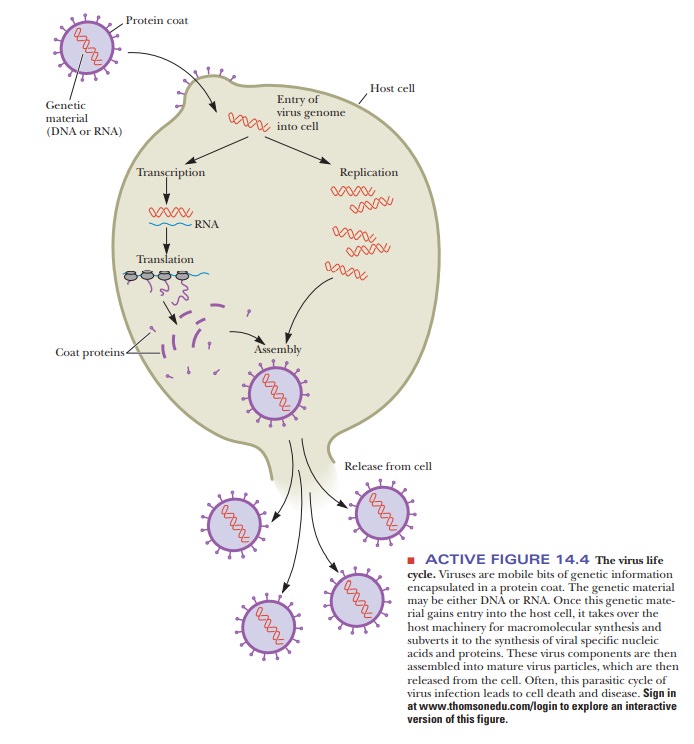Chapter: Biochemistry: Viruses, Cancer, and Immunology
Virus Life Cycles

Virus Life Cycles
Most viruses cannot survive for long periods outside cells, so they must quickly gain access to a cell. There are several mechanisms for gaining access, and preventing access to the cell has been a major focus of pharmaceutical companies trying to develop antiviral drugs.
Figure 14.4 shows a
generic example of a virus infecting a cell. The virus binds to the cell
membrane and releases its DNA into the cell. The DNA is then replicated by host
DNA polymerases and transcribed by host RNA polymerases. The transcription and
translation of the mRNA leads to the proteins that are necessary to make the
coat proteins of the capsid. New virions are produced and then released from
the cell. This is called the lytic
pathway, as the host cells are lysed by this process.

Viruses do not always lyse their host cells, however. A separate process called lysogeny involves the incorporation of the viral DNA into the host chromo-some. Simian virus 40 (SV40) is an example of a DNA virus. It appears to be spherical, but it is actually an icosahedron, a geometric shape with 20 faces that are equilateral triangles, as shown in Figure 14.5.

The
genome of this virus is a closed circle of double-stranded DNA, with genes that
encode the amino acid sequences of five proteins. Three of the five proteins
are coat proteins. Of the remaining two proteins, one, the large-T protein, is
involved in the develop-ment of the virus when it infects a cell. The function
of the fifth protein, the small-T protein, is not known.
The outcome of infection by SV40 depends on the organism infected.
When simian cells are infected, the virus enters the cell and loses its protein
coat. The viral DNA is expressed first as mRNAs and then as proteins. The large-T
protein is the first one made (Figure 14.6), triggering the replication of
viral DNA, followed by viral coat proteins. The virus takes over the cellular
machin-ery for both replication of DNA and protein synthesis. New virus
particles are assembled, and eventually the infected cell bursts, releasing the
new virus par-ticles to infect other cells.

The results are different when SV40 infects rodent cells. The
process is the same as far as the production of the large-T protein, but
replication of the viral DNA does not take place. The SV40 DNA already present
in the cell can be lost or can be integrated into the DNA of the host cell. If
the SV40 DNA is lost,
How does a virus infect a cell?
A virus must attach to a host cell before it can penetrate, which
is why so much research is involved in studying the exact mechanisms of viral
attachment. A common method of attachment involves the binding of one of the
spike proteins on the envelope of the virus to a specific receptor on the host
cell. Figure 14.7 shows an example of HIV attachment. A specific spike protein
called gp120 binds to a CD4 receptor
on helper T cells. After this happens, a co-receptor complexes with CD4 and
gp120. Another spike protein, gp41,
then punctures the cell so that the capsid can enter.

Related Topics